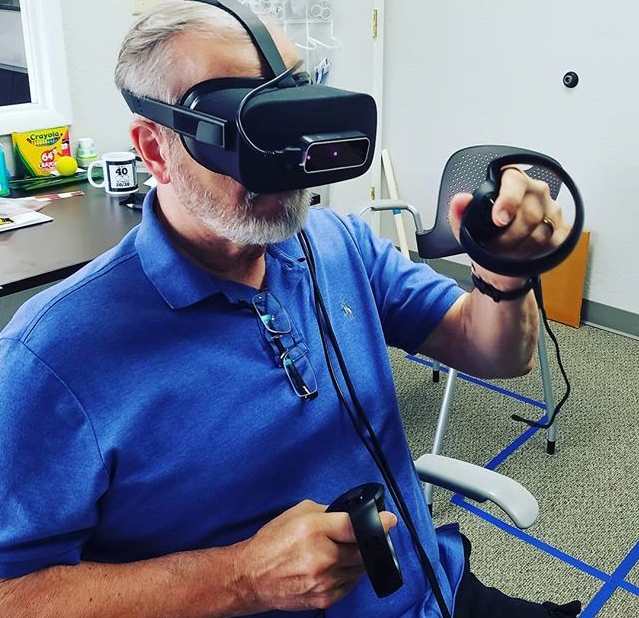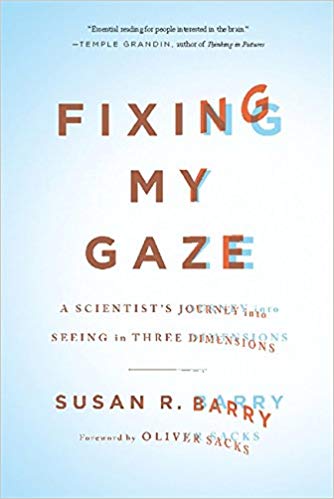Vision Therapy for Adults
Quite often vision therapy is associated with children; however, adults have as much need for this type of vision care as children and vision therapy can be successful at any age.

Neuroplasticity and Vision
The visual system is not fully developed at birth. Over the first two years of a child's life, visual experiences shape the neural architecture of the visual system. During the first four months, eye teaming begins to develop, and with this eye-hand coordination. By 8 moths depth perception is developing, and by 12 months these skills are quite robust and continue to improve. During these early months and years, an abnormal visual experience will likely inhibit the normal development of the visual system. Amblyopia, strabismus (eye turn), or pathology can significantly impact the child's visual skills.
Children, fortunately, have a highly plastic visual system - amblyopia, strabismus, and other disorders of binocular vision can often be corrected with good success if detected and treated early. Adults, however, have a less plastic visual system and will require more time and effort to overcome an abnormal visual experience in childhood.
Specific to vision, many tasks aimed at enhancing the plasticity of the visual system rely on components of perceptual learning. Perceptual learning is a broad term that requires repetition of a task to improve on a certain skill. Perceptual learning may be used in concern with accommodation training, binocular tasks, monocular tasks, and more. This is a reaffirmation that practice does indeed make perfect. Vision therapy is an excellent example of how neuroplasticity is used to help enhance visual function.
Stereo Sue
Dubbed “Stereo Sue” by neurologist Oliver Sacks in a New Yorker article by that name, Dr. Susan Barry is the author of the book Fixing My Gaze which describes her astonishing experience of gaining 3D stereovision after a lifetime of seeing in only two dimensions.

Dr. Barry was cross-eyed from early infancy and had three surgeries as a child that, according to her, "made my eyes look more or less straight." Dr. Barry did not develop stereovision until age 48 when she underwent optometric vision therapy under the guidance of a developmental optometrist. As a neurobiologist, Dr. Barry is in a unique position to tell her life story because she can, and does, give scientific explanations for why her eyes and brain could not produce 3-D images, and how she fixed that problem.
Listen to Dr. Barry describe the first time she saw in stereo:
Treatment for Adults with Convergence Insufficiency
The Convergence Insufficiency Treatment Trial found that for adults aged 19-30, 50% receiving office-based vision therapy for CI were either “improved” or “cured” after 12 weeks based on symptoms and clinical measures. It is possible that with more sessions there would have been a larger number of adults with CI benefiting from vision therapy. Also, investigators noted that the adults in this study improved the same amount clinically as children in another study suggesting that adults rate their symptomology differently than children.
In recent years, several randomized clinical trials have been published comparing the effectiveness of treatments for CI in children and adults. These studies have used both symptoms and clinical signs as outcome measurements. The results of these studies demonstrate that office-based vision therapy with home reinforcement is the most effective treatment for CI in children and adults. Additionally, studies and reviews have speculated that adult patients may be more successful due to their maturity, self-discipline, and likelihood of completing a therapy program (4,5,6)
Treatment for Adults with Lazy Eye
It was long thought that treating amblyopia, the medical term for lazy-eye, after the "critical age" of 8-12 years old was not possible. Unfortunately, many optometrists and ophthalmologists still believe, refer to, and share this outdated view. Research, clinical trials, and well-documented patient cases, now show that amblyopia can be treated well into adult hood.
In an excerpt from Stereopsis and amblyopia: A mini-review. Levi et al explain, "Brain plasticity is known to peak during a critical period in early childhood and to decrease thereafter (Bavelier et al., 2010; Movshon & Van Sluyters, 1981; Wiesel, 1982)." They go on to explain that this highlights the effectiveness of early intervention but the assumption that plasticity ends after a critical period has been detrimental to patient care.
Levi et al lament, "Amblyopic patients over the age of seven are often told that they will never be able to recover visual acuity or stereovision because their visual system is beyond the critical period for binocular vision. Young brains are certainly much more plastic than older ones, yet the last 15 years have shown that significant plasticity can still be induced beyond the critical period if appropriate input is provided." They share multiple references supporting this claim: Baroncelli, Maffei, & Sale, 2011; Bavelier et al., 2010; Hess, Thompson, & Baker, 2014; Levi, 2012; Levi & Li, 2009; Levi & Polat, 1996; Morishita & Hensch, 2008; Wong, 2012.
Though it can be more difficult to treat adults, there is evidence that improvements in acuity, depth perception, and vergence ability are all possible through vision therapy, eye surgery, and visual perceptual training. Amblyopia in adults can be successfully treated through a combination of lenses and active vision therapy including virtual reality programs.
Recent research (Ziak at al) has shown improved visual acuity as well as improved stereo acuity at statistically significant levels in amblyopic patients aged 17-69 using virtual reality vision therapy technology. Another recent study (Ho et al, 2019) also showed improved visual acuity and stereo acuity in amblyopic and strabismic patients aged 3-69 using virtual reality vision therapy technology who were previously unsuccessful in traditional patching or occlusion therapy. These studies are supported by another study by Vedamurthy et al where adult patients aged 19-56 with stereo-impairments (such as refractive amblyopia, alternating exotropia, and esotropia) trained weekly in a dichoptic virtual reality environment and the participants made measurable improvements in areas like visual acuity, reduced suppression, and stereo acuity. These studies all featured success using vision therapy activities in adult patient populations with varying diagnoses.
References
- Stereo Sue Barry: www.stereosue.com/who-is-stereo-sue/
- Stereo Sue article in the New Yorker
- Vision Therapy in Adults with Convergence Insufficiency: Clinical and Functional Magnetic Resonance Imaging Measures
- Scheiman M, Mitchell GL, Cotter S, Kulp MT, Cooper J, Rouse M, Borsting E, London R, Wensveen J. A randomized clinical trial of vision therapy/orthoptics versus pencil pushups for the treatment of convergence insufficiency in young adults. Optom Vis Sci. 2005;82:583–595.
- Anisometropic amblyopia: is the patient ever too old to treat?
- Plasticity of the Visual Cortex and Treatment of Amblyopia
- Perceptual learning as a potential treatment for amblyopia: A mini-review
- Ziak et al. Amblyopia treatment of adults with dichoptic training using the virtual reality oculus rift head mounted display: preliminary results.
- Ho et al. Binocular treatment for amblyopia in adults and children with low-pass filtering when occlusion therapy fails. ARVO 2019
- Vedamurthy I et al. 2016 Recovering stereo vision by squashing virtual bugs in a virtual reality environment. Phil. Trans. R. Soc. B 371: 20150264.
More Reading about Vision Therapy for Adults
You may also be interested in these blog posts:
The Vision Wiki
- Lazy Eye Treatments
- Optometric Vision Therapy
- Eye Exercises
- Pencil Pushups
- Brock String
- Vision Therapy
- Sports Vision
- Virtual Reality
- Red Green Glasses
- Vision Therapy for Adults
- Vision Therapy Apps
- Vectograms
- Eye Drops for Amblyopia
- Strabismus Surgery
- Eye Patching
- Prism Glasses
- Dichoptic Training
- Binasal Occlusion
- Eye Problems
- Binocular Vision
- Physiology of Vision
- Lazy Eye
- Reading
- Fields of Study
- Research
- Glaucoma
- Virtual Reality
- Organizations
